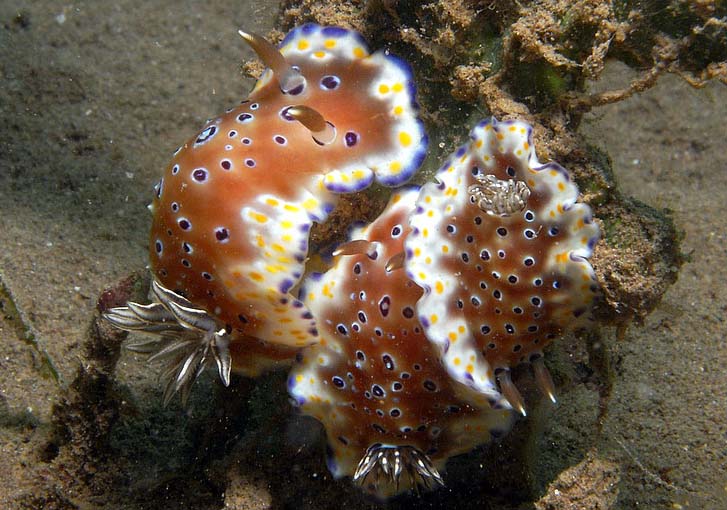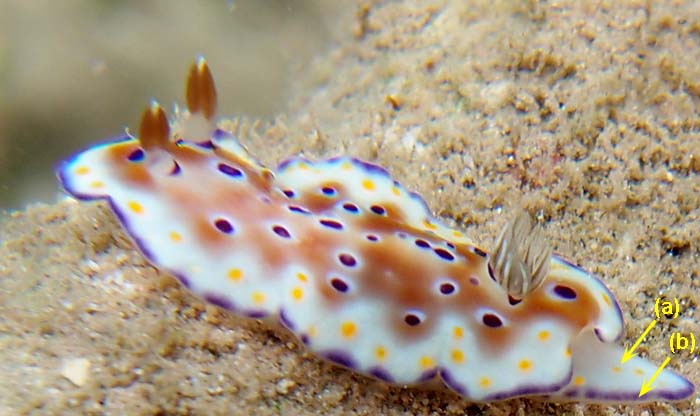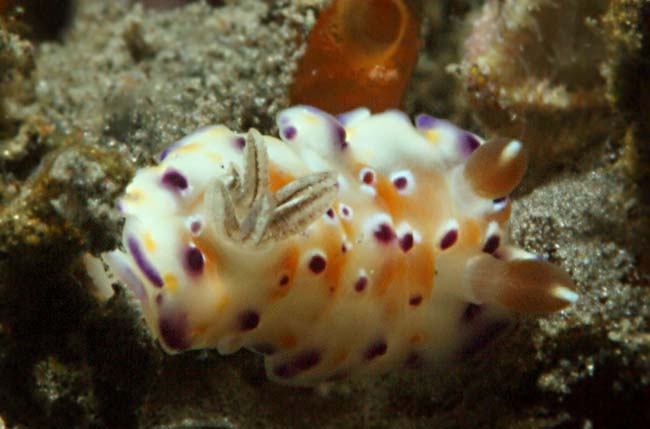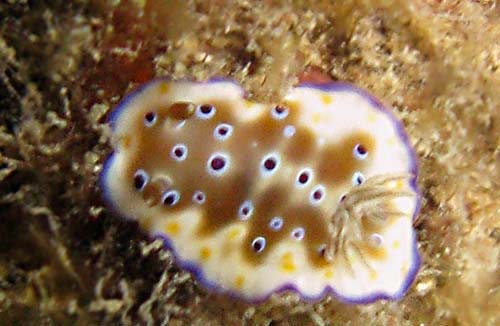This species has been observed on Reunion, Mauritius, Mayotte and Madagascar Islands
Species characteristics : A translucent creamy white mantle with a mottled orange to brownish patch covering the central part of the mantle
|

|
|
| Showing species characteristics... | Photo Fabrice Schubert Mayotte, Bandrele, 6 m , 3 January 2010, size : 40 mm |
|
Remarks :
Identification confirmed by Nathalie Yonow and Hsini Lin
Synonymous : (according Worms)
- Chromodoris tennentana (Kelaart, 1859)
- Doris tennentana Kelaart, 1859
- Chromodoris vicina, Eliot, 1904
- Glossodoris tennentana (Kelaart, 1859)
- Glossodoris vicina (Eliot, 1904)
Bibliographic data :
In an earlier publication (Rudman, 1987) Rudman considered G. cavae and C. vicina (Eliot, 1904), both described from Zanzibar, East Africa, to be synonyms of G. tennentanus (Kelaart, 1859), which was described from Ceylon (Sri Lanka)
Now, he still believe C. vicina is a synonym of G. tennentanus but that G. cavae is a distinct species.
According to Dr. Richard Willan : " I have decided that Goniobranchus tennentanusand Goniobranchus cavae belong to one very variable species. The supposed differences between them suggested by Bill Rudman on his Sea Slug Forum cannot be substantiated when many specimens are studied from many different localities across the Indian Ocean. Consequently put them all under Goniobranchus tennentanus on Nudi Pixel with a note that Goniobranchus cavae and Chromodoris vicina are both synonyms "
In, Atlas mondial des nudibranches (Debelius, 2007) they are considered as two differents species...Goniobranchus cavae and Goniobranchus tennentanus
Yonow, 2012, considered that they are two distinct species G. cavae and G. tennentanus
Bibliographic data :
The typical colour pattern: a central patchy ochre-brown dorsum with ocellated violet spots, a creamy sub-marginal band with yellow orange spots, a blue-violet margin, and ochre rhinophores and gills.
The sides of the body and foot are also creamy white with some large purple spots, ringed with white, on the sides of the body and smaller yellow spots near the edge of the foot.
The foot is edged with watery purple band which can be broken into a series of spots
There is a watery purple band around the mantle edge with some darker patches arranged evenly around the edge, and extending into the creamy white of the outer mantle
This species is similar to G. cave, C. cf geminus and G. collingwoodi but there are some differences
G. collingwoodii
G. tennentanus
Distribution
West Pacific
West Indian Ocean
Gills
Translucent with a dark brown, almost black, line down the two edges
Dark brown, sometimes with white spots.
White with purple tips
Rhinophores
Dark reddish brown with white specks
Reddish brown with a white tip
White with purple tips
Dorsum border
Bluish purple border and the white region inside has yellow spots and dark purple spots
Bluish purple border and the white region inside has yellow spots
An irregular washy purple border
A fine purple border (absent from our specimens) with a white region inside
Dorsum central area
Large orange-brown central patch scattering of fine white specks all over
Large orange-brown central patch with large purple spots each surrounded by a white ring
Large very variable in color orange-brown central patch with very variable amoung of dark purple spots ringed with white, with sometimes orange spots
Large brownish central patch with large purplish red spots or marks, usually ringed with white.
References :
Bill Rudman Sea slug site : Sea Slug Forum : Chromodoris tennentana
Nudipixel Chromodoris tennentana
Publications :
Edmunds, M. (1971) Opisthobranchiate Mollusca from Tanzania (Sub-Order: Doridacea. Zoological Journal of the Linnean Society, 50 : 339-396.
Eliot, C.N.E. (1904) On some nudibranchs from East Africa and Zanzibar. Part IV. Proceedings of the Zoological Society of London, (1904) : 380-406.
Johnson R.F. & Gosliner T.M. (2012) Traditional taxonomic groupings mask evolutionary history: A molecular phylogeny and new classification of the chromodorid nudibranchs. PLoS ONE 7(4): e33479
Kelaart, E.F. (1859) On some additional species of nudibranchiate Mollusks from Ceylon. Annals & Magazine of Natural History , IV: 267-270.
Rudman, W.B. (1987) The Chromodorididae (Opisthobranchia: Mollusca) of the Indo-West Pacific: Chromodoris epicuria, C. aureopurpurea, C. annulata, C. coi and Risbecia tryoni colour groups. Zoological Journal of the Linnean Society, 90 : 305-407.
Yonow N (2012) Opisthobranchs from the western Indian Ocean, with descriptions of two new species and ten new records (Mollusca, Gastropoda). ZooKeys 197: 1-129. doi: 10.3897/zookeys.197.1728
Other photos of Goniobranchus tennentanus :
Fabrice Schubert Mayotte, Bandrele, 6 m , 3 January 2010, size : 40 mm Three specimens... with the same pattern... |
 |
 |
Philibert Bidgrain Mayotte, Petite Terre, Le rocher, less 1 m, 6 October 2012, size, 20 mm The sides of the body and foot are also creamy white with some large purple spots, ringed with white, on the sides of the body and smaller yellow spots (a) near the edge of the foot. The foot is edged with watery purple band (b) which can be broken into a series of spots
|
Sully Bachel Reunion, Saint Denis, Le Barachois, 12 m, 24 November 2012, size : 15 mm
A juvenile pattern...
|
 |
 |
Sully Bachel Madagascar, Sainte Marie, passe de Lakana, 6 m, 19 October 2008, size : 15 mm
|
More photos from Indian Ocean
Mauritius, Goniobranchus tennentanus, at Riviere Noire, by Pierre Périès